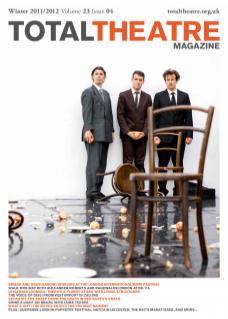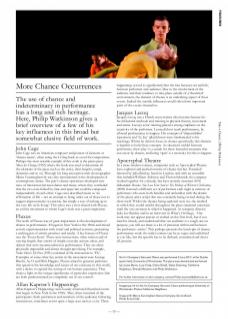John Cage
John Cage was an American composer and pioneer of aleatoric or ‘chance music’, often using the I-Ching book as a tool for composition. Perhaps the most notable example of this work is the piano piece Music for Changes (1951) where the book was used to determine all the elements of the piece such as the notes, their lengths, tempi, dynamics and so on. Through his long association with choreographer Merce Cunningham he was also instrumental in the development of contemporary dance. The pair’s chance operations developed new ways of interaction between dance and music, where they concluded that the two were linked by time and space but could be composed independently of each other. Cage once described music as ‘an affirmation of life – not an attempt to bring order out of chaos nor to suggest improvements in creation, but simply a way of waking up to the very life we’re living’. This ethos was a view shared with Fluxus, an artistic movement to whom Cage’s work was a great inspiration.
Fluxus
The work of Fluxus was of great importance to the development of chance in performance. It began in New York in the 1960s and mixed artistic experimentation with social and political activism, presenting a melting pot of artistic practices and media. A key feature of Fluxus was the ‘Event Score’. These were instructions, often written and of varying length, that consist of simple everyday actions, ideas, and objects that were recontexualised as performance. They are often physically impossible and always thought provoking. For example, Yoko Ono’s Fly Piece (1951) consisted of the instruction to ‘Fly’. Examples of some other key artists in the movement were George Brecht, Ay-O and Dick Higgins. Fluxus aimed to generate pathways that question the knowledge and nature of our existence in this world, with a desire to expand the setting of our human experience. They shone a light on the unique significance of particular experiences that are both predetermined yet completely out of our control.
Allan Kaprow’s Happenings
Allan Kaprow’s Happenings were loosely structured theatrical events that began in New York in the 1950s. They often consisted of the participants (both performers and members of the audience) following instructions, sometimes across quite a large area such as a city. These happenings served to significantly blur the line between art and life, between performer and audience. Due to the involvement of the audience and their tendency to take place outside of a ‘theatrical’ environment, the element of chance is an underlying aspect of these events. Indeed the outside influences would often form important parts of the events themselves.
Jacques Lecoq
Jacques Lecoq was a French actor-trainer who became famous for his influential methods and training in physical theatre, movement and mime. Lecoq’s actor training placed a strong emphasis on the creativity of the performer. Lecoq did not teach performance, he allowed performance to happen. His concepts of ‘disponsibilité’ (openness) and ‘Le Jeu’ (playfulness) were fundamental to his teachings. Whilst he did not focus on chance specifically, this element is implicit to both these concepts. As situations unfold between performers, their ‘play’ is a search for these beautiful moments that can occur by chance, and being ‘open’ is a necessity for this to happen.
Apocryphal Theatre
In a more modern context, companies such as Apocryphal Theatre have explored and pushed notions of chance further. Founded/ directed by Julia Barclay, based in London, and with an ensemble that included William Aichison and Theron Schmidt, the company worked together for a decade, but have recently (summer 2011) disbanded. Besides, You Lose Your Soul or The History of Western Civilisation (2009) featured a different set of performers each night (a mixture of performers who were both familiar and unfamiliar with the details of the piece) and a script that was constantly being revised during the show itself. Whilst the themes being explored were set, the method in which they would unfold throughout the piece remained uncertain until the very moment in which it happened. As company director Julia Lee Barclay said in an interview in What’s On Stage, ‘Our work may not appear precise or crafted on the first level, but if you watch it closely, and understand that our aesthetic is a rough one on purpose, you will see there is a lot of precision within and between the performer- artists.’ This perhaps presents the lynch-pin of chance performance work: the wider context can be as vague and undefined as you like, but the specific has to be defined, committed and above all, present.
No I In Company’s Secured Chaos was performed 2 June 2011 at the Dytche sports field, University of Winchester. The piece was devised and performed by Louise Byrne, Lucy Cody, Claire Devall, Daisy Greening, Catherine Neighbour, Sheida Moharrer and Philip Watkinson. For further information on the company, contact Philip at pmw26@kent.ac.uk

